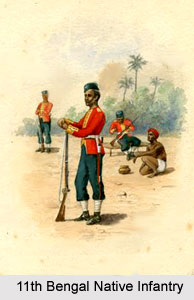 The 11th Bengal Native Infantry was an infantry battalion of the British East India Company that existed from the year 1825 to 1922. It was a part of the Bengal Native Infantry under the Army of the Bengal province, before the Indian Rebellion of the year 1857. The Bengal Army was the military of Bengal Presidency and was amongst the 3 main Presidency Armies in British India. The Army of Bengal province operated under British East India Company. Later the British Empire in India took control over the Company and the three Presidency Armies, namely the Bengal Army, the Madras Army and the Bombay Army after the Government of India Act 1858 was institutionalized. The 11th Bengal Native Infantry unit was also incorporated as a part of the Bengal Command. The battalion was also known as the 2nd 11th (Rajput) Bengal Infantry and as the 11th Rajputs. King Edward VII acted as the Colonel-in-Chief of the battalion in the year 1904.
The 11th Bengal Native Infantry was an infantry battalion of the British East India Company that existed from the year 1825 to 1922. It was a part of the Bengal Native Infantry under the Army of the Bengal province, before the Indian Rebellion of the year 1857. The Bengal Army was the military of Bengal Presidency and was amongst the 3 main Presidency Armies in British India. The Army of Bengal province operated under British East India Company. Later the British Empire in India took control over the Company and the three Presidency Armies, namely the Bengal Army, the Madras Army and the Bombay Army after the Government of India Act 1858 was institutionalized. The 11th Bengal Native Infantry unit was also incorporated as a part of the Bengal Command. The battalion was also known as the 2nd 11th (Rajput) Bengal Infantry and as the 11th Rajputs. King Edward VII acted as the Colonel-in-Chief of the battalion in the year 1904.
History of 11th Bengal Native Infantry
The 11th Bengal Native Infantry was formed by the British East India Company as the 2nd Extra Battalion, Bengal Native Infantry in the year 1825. The regiment was re-designated as the 70th Bengal Native Infantry in 1828. The army unit was re-designated many times over a number of years, such as the 11th Bengal Native Infantry from 1861 to 1885; the 11th Bengal Infantry from the year 1885 to 1897; and the 11th (Rajput) Bengal Infantry from 1897 to 1901.
Military Operations of 11th Bengal Native Infantry
The British Indian Army unit participated in the Second Anglo Sikh War and fought in a number of military campaigns and battles, namely, the Battle of Chillianwala, the Second Opium War in China, the Battle of Goojerat (now Gujarat), the Third Anglo Burmese War and the Third Afghan War. The 11th Bengal Native Infantry regiment also provided significant service during the First World War. During the Great War, the unit was initially allocated on duties of internal security with the Presidency Brigade, 8th Lucknow Division. Later the 11th Rajputs took part in the campaign at Mesopotamia and was attached to the 33rd Indian Brigade, 12th Indian Division.
Development of 11th Bengal Native Infantry
After the First World War, the British Government of India restructured the Indian army. The different single battalion infantry regiments were united together in order to create multi battalion regiments. As a result, the 11th Bengal Native Infantry unit was regrouped as the 5th Battalion, 7th Rajput Regiment.
After the political withdrawal of the British Empire in India, the country attained freedom on 15th August 1947. As a result, the Partition of India divided the nation in order to form the 2 newly formed sovereign states, namely the Union of India and the Dominion of Pakistan. The British Indian Army was accordingly shared amongst Indian and Pakistan. The military unit of the 11th Bengal Native Infantry was assigned to the modern Indian Army.
Designations of 11th Bengal Native Infantry
The regiment, initially known as the 2nd Extra Battalion, Bengal Native Infantry regiment of the British Indian Army, held a number of designations through out its service during the regrouping and renumbering of the army. These are listed as follows -
* 2nd Extra Battalion, Bengal Native Infantry in 1825
* 70th Bengal Native Infantry in 1828
* 11th Bengal Native Infantry from 1861 to 1885
* 11th Bengal Infantry from 1885 to 1897
* 11th (Rajput) Bengal Infantry from 1897 to 1901
* 11th Rajput Infantry from 1901 to 1903
* 11th Rajputs in 1903
* 5th Battalion, 7th Rajput Regiment in 1922
* Allocated to the Indian Army in 1947



















